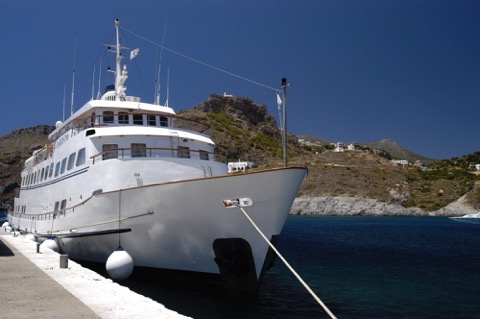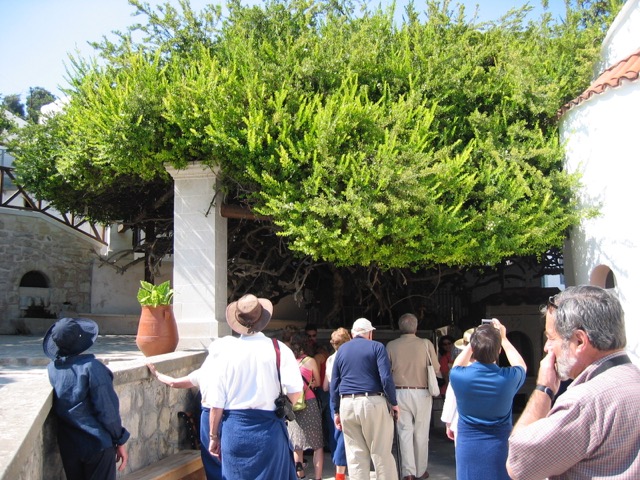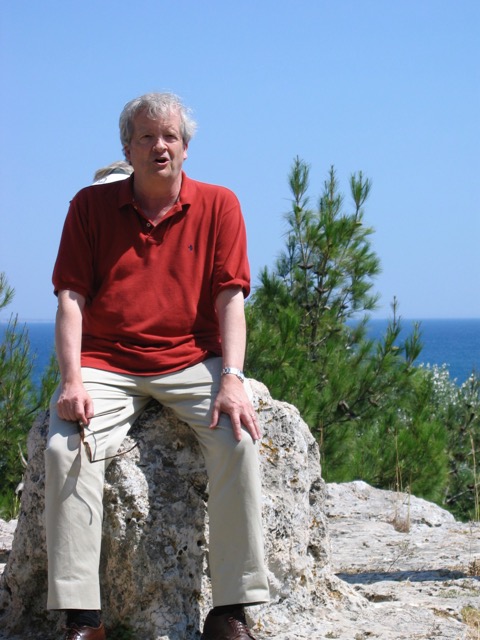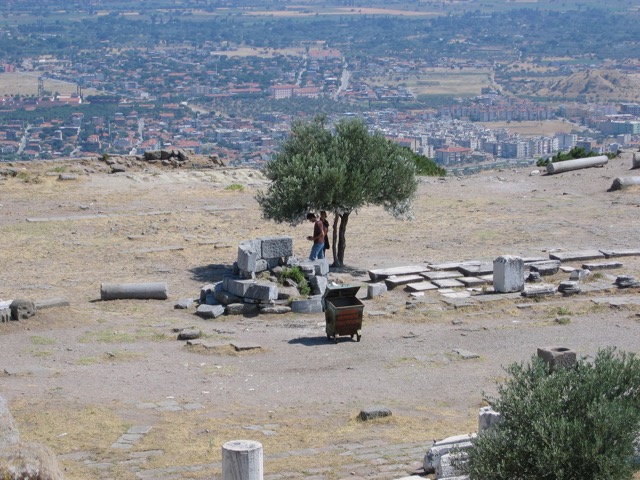The CHS team is happy to share the following Q&A with Jennifer Kellogg, former executive assistant for the Center for Hellenic Studies. Jennifer’s duties as a former CHS executive assistant included helping with the organization of the Harvard Alumni Association travel study programs to Greece, led by professor Gregory Nagy, that combine travel with the ancient Greek literature. Participants are not only visiting the ancient sites but also the ancient texts. Jennifer has beautiful stories to share with the community from her experience.
Q. Can you tell us a bit about your travels to Greece?
I travelled to Greece in 2001, 2003, 2004, 2006, and 2009 with the Harvard Alumni Association. I had a hand in organizing these tours and optimizing the itineraries to fit Greg Nagy’s educational objectives. Each year’s program was a little different, allowing us to explore variations on our themes, based on Greg’s research interests. We toured over land and by sea, sailing in boats owned by a previous partner of the HAA, Travel Dynamics Inc. Travel Dynamics had many years of experience in operating their ships and ground teams and they were very open to our customization and suggestions.

Each itinerary had a theme and several times we veered off the beaten path visiting places that are outside of traditional travel itineraries which usually visit mainland Greece, Crete, and the Cyclades. We visited islands such as Kythera, Ios, Syros, and Patmos, and archaeological sites in Turkey such as Sardis and Pergamon. Our objective was to visit the highlights of ancient Greek civilization while also including special places that represented lesser-known corners of the ancient world as well as the Byzantine and Ottoman phases of Greek history.
Q. What are the most vivid memories from your travels?
Greg Nagy always prepares his travelers with highlights from ancient Greek song culture prior to visiting a site. Most of our itineraries had a “sourcebook” of ancient texts which we would review before and after visiting a place. A sense of the imaginative potential, awe, and wonder would be created in travelers’ minds even before they set foot in a place. I will always remember how the ancient sites “came to life” with Greg and our guides as each traveler experienced for themselves the beauty of ancient civilization and the mystery of its ruins. One such place is the Argive Heraion, where the remains of the temple are very scanty. The site is a dry hilltop overlooking the fruit groves near Argos. Yet this site always becomes so much more when traveling with Greg because of what it represents in Greek song culture and hero cult. [For more information about the Heraion, read the posting of 03.16.2016 by Greg Nagy on Classical Inquiries.]
For me personally, some of my most enduring memories are of stepping into forgotten churches and monasteries. I treasure my memories of visiting the village of Kritsa in Crete, where there is a thirteenth century church with simple yet very touching frescoes. Our tour guide knew that this village is where Jules Dassin filmed his 1957 movie, He Who Must Die, based on the Kazantzakis novel Chris is Re-crucified. She asked some old-timers in a café about the film and they recounted stories of their youthful escapades on set.
I keep an icon of the Panagia Myrtidiotissa—the Virgin of the Myrtle Leaves—on my desk to remind me of the times we visited two churches dedicated to this aspect of the Virgin Mary. In Kythera, the icon of the Virgin was found in a myrtle bush in the 14th century. In Crete, there is a monastery of the Panagia Myrtidiotissa where a very old myrtle tree is an object of pilgrimage. My icon comes from the nuns in Crete and reminds me of my precious connection to the natural and supernatural Greek world.

Q. Can you tell us a bit about your visit to the Menelaion? What was the significance of this site in ancient Sparta, and what was it like to visit it today?
We visited the Menelaion as part of a 2004 tour that included the Peloponnese. Our purpose was to discuss Greek song culture, hero cult, and myth while visiting ancient sites and experiencing a sense of place.
The Menelaion is a small site on a hilltop overlooking the Evrotas river and the Taygetos mountains. It was excavated in the 1920s and then again in the 1970s. On the site, remains of Neolithic and Mycenaean settlements were found, together with a Classical temple dedicated to mythological figures Helen and Menelaus. Votive offerings found at the sanctuary show that both Helen and Menelaus were worshipped as a divine couple by both men and women from the Spartan community. Helen and Menelaus were seen as divine ancestors to the Spartans and offered generative and protective powers in the pursuits of family, harvest, and battle.
The Menelaion site is up a steep hill unfit for tour buses, so our group was told that they would have to walk about a mile or so uphill. We initially set out with gusto, but some of our elderly members started to flag along the way. A farmer harvesting his olive groves met us on the way up and offered to transport our guests on his tractor. By the time we all reached the summit, whether on foot or in a bumpy tractor bed, we understood what the supplicants coming to the shrine must have experienced!
As we sat among the ruins of the temple and took in the views, Greg told the story from Herodotus about a nurse bringing an unsightly baby to the Menelaion and experiencing a theophany wherein Helen blessed the child with incredible physical beauty (Herodotus Book 6).
Q. What did you gain from this experience? How do you think traveling to Greece under this program has affected you on a professional and a personal level?
I gained the most from my interactions with people, both the participants and the Greeks we worked with and met on the road. I acted as a kind of concierge, teaching assistant, and ambassador for Harvard. As a fluent Greek speaker, I often had a hand in negotiating with the Greek ground crew and local vendors— bus drivers, our wonderful guides, hotel staff, waiters, etc— and I loved being able to help translate for guests and troubleshoot potential misunderstandings and problems. I have always made it a priority to help the American guests I bring to Greece understand and make connections with the Greek people.

I thought I was already a seasoned traveler in Greece, but my experiences leading travel study tours helped me to become more resilient and open to the unexpected. There were crises—taking guests to the hospital and dealing with a bomb threat hoax—and there were moments of joy, like listening to Greg recite Homer on top of a sacred rock overlooking the harbor of Ios. There were also a few instances of personal catharsis, like when I severely panicked while giving my first lecture to a group of Harvard alumni and learned to trust myself and my voice.
Q. What advice would you give to someone who’s thinking of traveling to Greece with one of these travel study programs?
The most important thing before signing up for a tour is to decide what kind of traveler you are: are you comfortable with a structured itinerary or are you independent and averse to groups? The type of travel study programs organized by the Harvard Alumni Association are much more informative and rigorous than a strictly leisure tour where you also visit some archaeological sites. It’s important to review staff and itinerary and try to assess your preferences. I also advise my friends thinking of traveling to Greece not to hesitate because of the news cycle or the ongoing crisis. Greeks are among the most hospitable people in the world and the best thing you can do to “help Greece” is visit, interact with people, and see beyond the headlines.

***
Jennifer Kellogg holds a doctorate in Languages and Literatures from the Université Libre de Bruxelles (ULB). Her research interests are the poetry of George Seferis, Asia Minor Hellenism, and literary translation.
